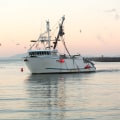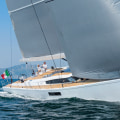Sailing boats are some of the most exhilarating and luxurious vessels you can get out on the open water. Whether you’re looking to explore untouched coastlines, or simply enjoy a relaxing day out on the waves, sailing boats are the perfect way to do it. From sleek racing yachts to classic schooners, there is something for everyone when it comes to sailing boats. Here we will take a look at the different types of sailing boats available, and what you need to know before you get out on the water. Sailing is an incredibly popular pastime and recreational activity, as well as a competitive sport.
Whether you want to explore new places, challenge yourself, or simply relax on the water, sailing is a great way to do it. Before taking the plunge, however, it's important to understand the basics of sailing and the different types of boats available. This article will provide an overview of sailing boats and the various factors to consider when choosing one. At its core, sailing involves using the wind to propel a boat across the water.
To make this happen, boats are outfitted with sails that capture the wind and generate power. The sails are held in place by a system of ropes and pulleys known as rigging. The hull of the boat is designed to provide stability and allow the boat to move through the water. Navigation is also an important aspect of sailing, which involves understanding how to interpret maps and charts as well as the effects of wind and currents on your course.
Dinghies
are small boats typically used for recreational sailing.They are lightweight and easy to maneuver, making them ideal for beginner sailors. Dinghies have either one or two masts with a single sail and are typically powered by oars or an outboard motor. They can be sailed solo or with a crew and are great for daysailing or racing.
Keelboats
are larger vessels typically used for longer voyages. They usually have one or two masts with more complex rigging than dinghies, and they usually have an inboard motor as well as sails.Keelboats are heavier and less maneuverable than dinghies but offer more stability in rough conditions. They can accommodate several people and are ideal for cruising.
Multihulls
are boats with two or more hulls connected by a frame. They offer greater stability than monohulls and can be sailed faster due to their lighter weight. Multihulls come in all sizes, from small catamarans suitable for daysailing to large trimarans that can take you on long-distance voyages.When choosing a boat, it's important to consider your budget, experience level, and where you plan to sail. You should also consider the type of boat you want: dinghy, keelboat, or multihull. It's also important to factor in maintenance costs, such as repairs and storage fees, and safety features such as life jackets and safety lines. Sailing can be an incredibly rewarding experience, but it's important to take the time to understand the basics before getting started. This article has provided an overview of sailing boats and some of the factors to consider when selecting one.
Whether you're looking for a dinghy for racing or a keelboat for cruising, there is something for everyone. Be sure to do your research and take safety precautions before setting sail!
Types of Sailing Boats
DinghiesA dinghy is a small, lightweight sailing boat often used for recreational sailing or racing. Dinghies are easy to maneuver and can be sailed single-handedly, making them ideal for beginners. They typically range in length from 7 to 11 feet and can be rowed, sailed, or towed behind another boat.Dinghies are also relatively inexpensive and easy to transport, which makes them a popular choice for sailors of all skill levels.
Keelboats
Keelboats are larger than dinghies and typically range from 14 to 20 feet in length. They are designed to be sailed in larger bodies of water and feature a deeper keel, which makes them more stable than dinghies. Keelboats also have a larger sail area, allowing for faster speeds and greater control in heavier winds. They are more difficult to maneuver than dinghies and require at least two people to sail safely.Multihulls
Multihulls are boats with two or more hulls that are connected by a frame or bridge.They offer excellent stability in rough waters and can reach high speeds due to their large sail area. Multihulls come in a variety of sizes, from small dinghies to large catamarans and trimarans. While they can be difficult to maneuver, they are ideal for long-distance cruising or racing.
Boat Maintenance and Safety
Boat MaintenanceRegular maintenance is essential to keep your boat in top condition and ensure your safety while sailing. You should check the hull for any damage, especially after a long journey.Additionally, you should inspect the engine, sails, rigging, and other essential components. It's also important to check the fuel and oil levels, as well as the battery. You should also check all safety equipment on board, such as life jackets, flares, and first aid kits. It's also important to clean and lubricate the boat regularly. This will help to prevent rust and corrosion, as well as reduce wear and tear.
Finally, you should check the lines and halyards for any signs of wear or damage.
Safety Considerations
When sailing, it's important to take safety precautions. This includes wearing a life jacket at all times and ensuring that all safety equipment is in good working order. You should also check the weather conditions before you set sail. Additionally, be aware of your surroundings and avoid areas with strong currents or heavy traffic. It's also important to have a well-stocked first aid kit on board in case of an emergency. When sailing, it's important to take safety precautions. This includes wearing a life jacket at all times and ensuring that all safety equipment is in good working order. You should also check the weather conditions before you set sail. Additionally, be aware of your surroundings and avoid areas with strong currents or heavy traffic. It's also important to have a well-stocked first aid kit on board in case of an emergency.Finally, always have a plan in place for what to do if you are stranded or lost at sea.
The Basics of Sailing
Sailing is a popular pastime and recreational activity, as well as a competitive sport. It involves the use of wind to power a boat across the water. To get started, there are a few key concepts that are important to understand.Terminology:
First, it’s important to understand the basic terminology used when talking about sailing.Some of the most common terms include hull, keel, sail, and mast. The hull is the main body of the boat, and the keel is a fin-shaped structure that helps keep the boat stable and upright in the water. The sail is the large cloth that is attached to the mast and used to catch the wind, while the mast is the vertical pole that supports the sail.
Types of Sails:
There are several different types of sails, all of which are designed to capture different amounts of wind and provide different levels of power.The most common types of sails include jibs, spinnakers, and mainsails. Each type of sail has its own advantages and disadvantages, so it’s important to understand their differences before choosing one for your boat.
Rigging:
Rigging refers to the lines and cables that connect the sails to the boat and allow them to be controlled by the sailor. There are two types of rigging: standing rigging and running rigging.Standing rigging is made up of cables that stay in one place, while running rigging consists of lines that can be adjusted to control the sails.
Navigation:
Navigation is an important part of sailing, as it helps sailors find their way from one destination to another. Basic navigation techniques involve using landmarks, charts, and compass headings to determine direction. More advanced navigation techniques involve using GPS systems and other electronic devices.Choosing the Right Boat
When it comes to selecting the right sailing boat, there are a few important factors to consider. Firstly, you need to decide on your budget. Sailing boats can range from small dinghies to large luxury yachts. You should also take into account the size of the boat, as this will determine how many people can be onboard.Furthermore, you should consider what type of sailing you plan to do and whether you would like a fixed keel or a swing keel boat. Lastly, you should think about the purpose of the boat; whether it is for leisure sailing, racing, or a combination of both. Once you have considered these factors, it is important to visit a few boat dealers or sail clubs to get a feel for the boats available in your price range. You should also speak to experienced sailors who can give you advice on what type of boat is best for your needs. Finally, it is a good idea to take a few trial sails on different boats before deciding which one is right for you. Sailing boats are a great way to explore the open waters and take in the beauty of nature.
It is important to understand the basics of sailing, the different types of sailing boats, boat maintenance, and safety before making a purchase. It is also important to select the right boat for your needs, as this will determine how much enjoyment you will get from sailing. Whether you are an experienced sailor or a novice, sailing can be a fun and rewarding activity. With the right boat and some preparation, you can look forward to an enjoyable and safe sailing experience. This article has provided an overview of sailing boats and the various factors to consider when choosing one.
Ultimately, it is up to the individual to do their own research and make an informed decision on which boat best suits their needs. With the right boat and some preparation, you can look forward to an enjoyable and safe sailing experience.


